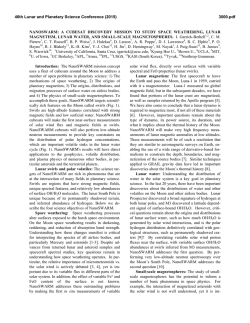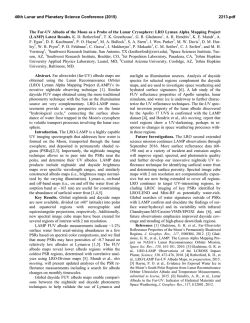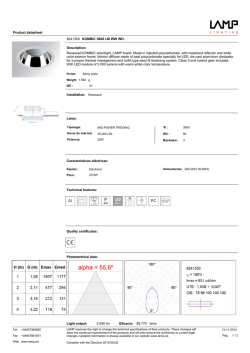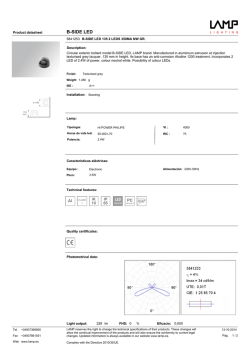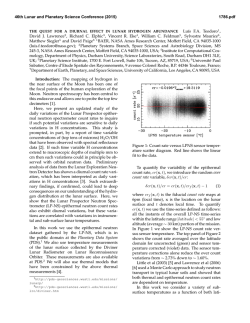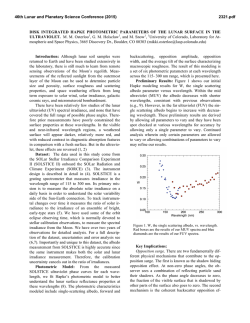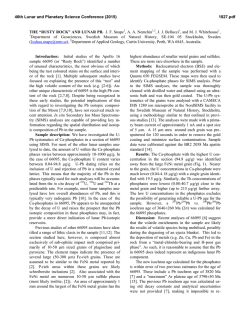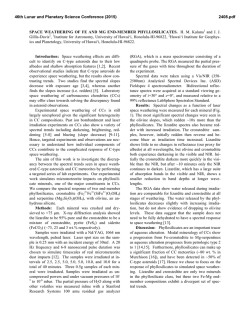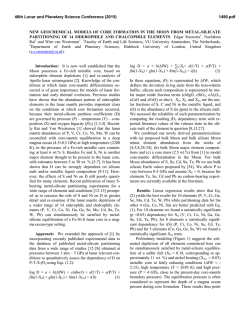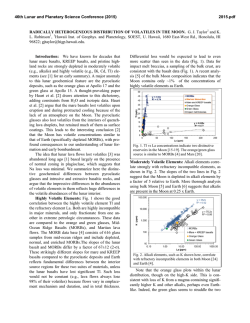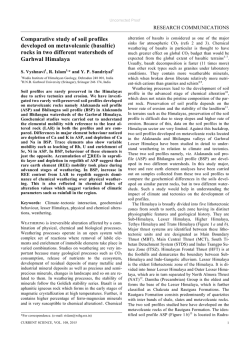
FAR-ULTRAVIOLET CHARACTERISTICS OF LUNAR SWIRLS
46th Lunar and Planetary Science Conference (2015) 2648.pdf FAR-ULTRAVIOLET CHARACTERISTICS OF LUNAR SWIRLS. A. R. Hendrix1, T. K. Greathouse2, K, D. Retherford2, K. E. Mandt2, G. R. Gladstone2, D. E. Kaufmann3, D. M. Hurley4, P. D. Feldman5, W. R. Pryor6, M. A. Bullock3, S. A. Stern3; 1Planetary Science Institute, Tucson, AZ, [email protected]; 2Southwest Research Institute, San Antonio, TX; 3Southwest Research Institute, Boulder, CO; 4Applied Physics Laboratory, Johns Hopkins University, Laurel, MD; 5Johns Hopkins University, Baltimore, MD; 6Central Arizona College, AZ Introduction & Background: Lunar swirls are often described as bright sinuous regions of the Moon that appear to be relatively immature – i.e. less spaceweathered than surrounding regions. Swirls are mysterious but seem to be linked to the interaction between the solar wind and the lunar magnetic anomalies (e.g., [1]). Commonly-studied swirls include Mare Ingenii (in a mare-highlands boundary region), Reiner Gamma (in a mare region), and Gerasimovich (in a highlands region). Swirls are known to be surface features: they have no expression at radar depths [2], and craters on swirls that penetrate the bright surface terrain reveal underlying dark material [3]. Swirls exhibit no topography. Using Clementine and Lunar Prospector data, it was found [4] that all swirls are associated with areas of magnetized crust, and that swirls exhibit spectral characteristics similar to immature material and generally have slightly lower FeO values compared with their surroundings. Lunar swirls exhibit VNIR characteristics consistent with a reduced amount of space weathering compared to surrounding regions, which suggests a reduction in solar wind interaction at those locations. Nanophase iron, responsible for the spectral characteristics attributed to space weathering, is created by vaporization/deposition by micrometeorite impacts and sputtering/reduction by solar wind ions. On the swirls, the decreased proton flux (deflected by the magnetic anomalies) slows the spectral effects of space weathering (relative to nonswirl regions) by limiting the nanophase iron production to micrometeoroid impact vaporization/deposition (e.g., [5]). Analysis of Clementine spectra [6] of lunar swirls indicates that swirl surfaces are regions of retarded weathering, and that the production of larger-grained (>40 nm) nanophase iron dominates in these locations as a result of charged particle sorting by the magnetic field. In a study of M3 data of the 2.82 µm feature indicative of OH abundance within and near swirls, [5] found that swirls are depleted in OH relative to their surroundings, consistent with the idea of a divergence of solar wind in these zones. An electrostatic dust transport mechanism may be at play [7], where charged fine dust is attracted into bright areas of swirls, and repelled from dark lanes within swirls. The authors point out that lunar swirls do not exhibit VNIR spectral trends typical of imma- ture lunar soils, using Clementine data. M3 data [8] show that the band depth (1 and 2 µm absorptions) does not change between the swirls and their surrounding terrains, as would be expected if a lack of weathering played a role; weathering generally degrades the absorption band. Those authors suggest that the brighter soil at swirls is due to a lack of ‘fairy castle’ structure in these magnetically-anomalous regions. In the ultraviolet, lunar space weathering effects are the reverse of those at VNIR wavlengths: more weathered regions are bluer than less weathered regions [9], due to a weathering-related degradation of the UV absorption edge in iron-bearing silicates. Indeed, LROC color results of the Reiner Gamma swirl [10] show a low 321/415 nm ratio (i.e., steep UV slope), consistent with a lack of space weathering compared to the surrounding mature mare terrain. For the Gerasimovich swirl, located in low-iron (<5wt% FeO) highlands, regions within the swirl have higher 321/415nm ratio values than the mature background (consistent with the exposure of fresh plagioclase-rich soil). The 321/415nm ratio values for the Gerasimovich swirl are similar to those of the rays of Tycho, Jackson, and Necho [10]. In this work, we investigate the far-ultraviolet (FUV) characteristics of swirl regions to broaden the spectral coverage of these mysterious regions and further illuminate their possible origins. As pointed out [7], lunar swirls could represent regions on the Moon where both solar wind and micrometeoroid bombardment are important: where solar wind bombardment produces nanophase iron (and the lack of this nanophase iron in swirl regions makes them visibly bright and UV dark) but maturation via micrometeoroid bombardment is important for producing glass-welded aggregates and fine-grained soils that can enhance weathering effects at VNIR wavelengths. It is also likely (e.g. [5]) that sputtering/vapor deposition, implanted solar wind hydrogen, and agglutination share responsibility for creating the range in nanophase iron particle sizes that produce the spectral effects of space weathering. The study of the shorter wavelengths probed by LAMP allows for further constraints to be placed on grain size and weathering effects. LRO/LAMP Data: The Lunar Reconnaissance Orbiter (LRO) is currently in orbit at the Moon. The Lyman Alpha Mapping Project (LAMP) onboard LRO has been making measurements of the lunar nightside, 46th Lunar and Planetary Science Conference (2015) dayside and atmosphere since September 2009. The LAMP instrument [11] is a photon-counting imaging spectrograph. The entire passband is 57–196 nm, in the far-UV (FUV) spectral region. For dayside measurements, the instrument is operated in “pinhole” mode, with the entrance aperture reduced by a factor of 736. The instrument was usually nadir-pointed in LRO’s characteristic 50-km lunar orbit of the prime mission and provided ~500 m resolution. In LRO’s extended mission the orbit has been modified to an elliptical frozen orbit that saves fuel and results in up to ~2 km resolution when at the North pole. To determine the lunar FUV reflectance, we divide the LAMP data from each latitude bin by the full-disk solar spectrum from SORCE SOLSTICE [12], taken for the day of each observation and convolved to agree with the LAMP resolution and line spread function. Sample LAMP reflectance spectra are shown in Fig. 1. Past analyses of LAMP dayside data (e.g. [13]) have shown that spectral slopes in the 175-190 nm region are good indicators of weathering and composition. (e.g., Fig. 1, 2). 2648.pdf LAMP results in the Reiner Gamma swirl region show that the swirl is relatively dark in the FUV (166187 nm) compared to the surrounding terrain. In addtion, the swirl region does not appear to exhibit a significant spectral slope, whereas the surrounding terrain is spectrally blue as is typical of mature mare terrains. We also investigate the Gerasimovich swirl as a comparison point and look into the strength of the H2O band at 165 nm in the swirls as measured by LAMP. Figure 2. Model spectra of average lunar terrains with varying small amounts of H2O added in an intimate mixture (from [8]). The slope across the 175-190 nm region is insensitive to H2O but sensitive to inherent composition and weathering (e.g., Fig. 1). Figure 1. Sample LAMP spectra of lunar terrains: a typical highlands region and a typical mare region, and two “fresh” regions: a bright ray and the young Giordano Bruno crater for comparison. Representative statistical error bars are shown. LAMP Results: In general, nearly all regions of the Moon are spectrally blue (i.e. increasing in albedo with decreasing wavelength) (Figs. 1, 2) in the LAMP bandpass, due to the surface-scattering nature of the light interaction with the grains combined with the optical constants of the compositional materials. Mare regions are bluer than highlands regions due to their higher concentrations of opaques. Also, more weathered regions become spectrally bluer in the FUV due to the spectral contributions of nanophase iron [9], while less weathered regions are less spectrally blue, or are spectrally relatively red. References: [1] Kramer, G. et al. (2011), EOS, 92, 413. [2] Neish, C. et al. (2011) Icarus, 215, 186. [3] Lawrence, S. (2011) Lunar Swirls Workshop without Walls [4] Blewett, D. et al. (2011) JGR, 116, E02002, doi:10.1029/2010JE003656. [5] Kramer, G. et al. (2011b), JGR, 116, E00G18, doi:10.1029/2010JE003729. [6] Kramer, G et al. (2011a), JGR, 116, E04008, doi:10.1029/2010JE003669. [7] Garrick-Bethell, I. et al. (2011) Icarus, 212, 480. [8] Pieters, C. et al., (2014) LPSC #1408. [9] Hendrix. A. R. & F. Vilas (2006) A.J., 132, 1396-1404. [10] Denevi, B. et al. (2014) JGR, 119, doi:10.1002/2013JE004527. [11] Gladstone, G. R. et al. (2010) SSR, 150, 161-181. [12] McClintock et al. (2000) Proc. SPIE Earth Obs. Syst., 4135, 225– 234. [13] Hendrix et al. (2012) JGR, 117, E12001, doi:10.1029/2012JE004252.
© Copyright 2024
